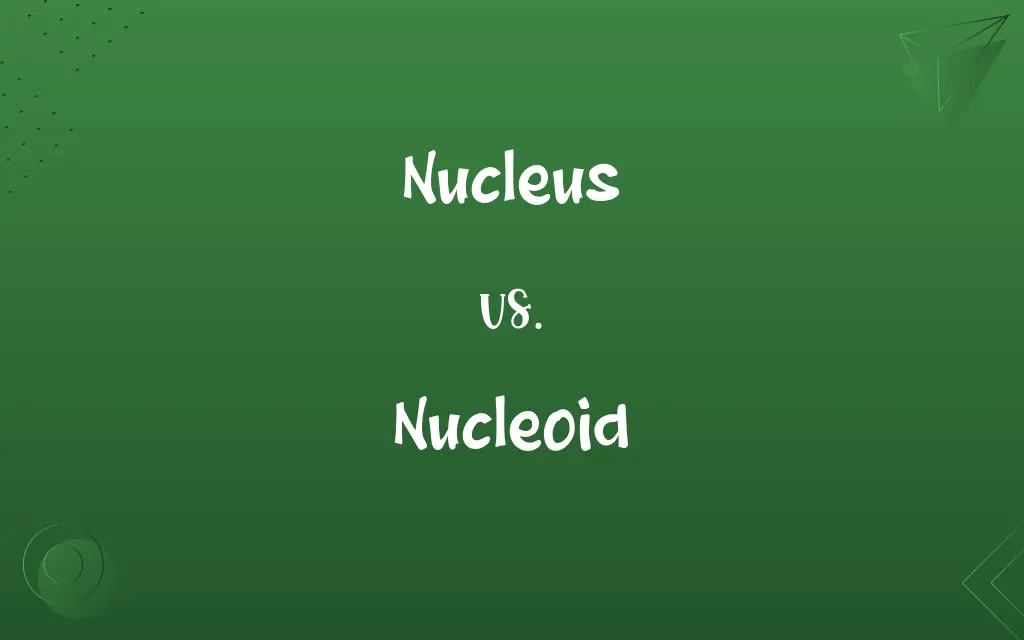Nucleus vs. Nucleoid: Know the Difference

By Shumaila Saeed || Published on February 26, 2024
The nucleus is a membrane-bound organelle containing chromosomes, while the nucleoid is a non-membrane region in prokaryotes containing DNA.

Key Differences
The nucleus is a prominent organelle in eukaryotic cells, characterized by its membrane-bound structure. It contains the cell's genetic material, organized as multiple linear DNA molecules in complex with proteins to form chromosomes. In contrast, the nucleoid is found in prokaryotic cells like bacteria. It is not enclosed by a membrane and contains a single, typically circular, DNA molecule.
Shumaila Saeed
Feb 26, 2024
In the nucleus, DNA is organized with histones into a structure known as chromatin. This organization facilitates the regulation of gene expression and DNA replication. The nucleoid, however, lacks histones, and the DNA is more freely floating within the cell, often attached to the plasma membrane for spatial organization.
Shumaila Saeed
Feb 26, 2024
The nucleus is a hallmark of complexity in eukaryotic cells, playing a central role in cell function, including growth, metabolism, and reproduction. It also contains the nucleolus, where ribosomal RNA is synthesized. The nucleoid, being simpler in structure, reflects the more basic organization of prokaryotic cells, which are generally smaller and less complex than eukaryotic cells.
Shumaila Saeed
Feb 26, 2024
The nucleus's membrane, known as the nuclear envelope, contains nuclear pores that regulate the transport of molecules between the nucleus and the cytoplasm. This feature is absent in the nucleoid, as there is no membrane separating it from the cytoplasm.
Shumaila Saeed
Feb 26, 2024
The nucleus undergoes a process of disassembly and reassembly during cell division in eukaryotes, ensuring proper segregation of chromosomes. In cells with a nucleoid, cell division is typically through a simpler process, like binary fission, where the DNA is replicated and distributed to the daughter cells.
Shumaila Saeed
Feb 26, 2024
ADVERTISEMENT
Comparison Chart
DNA Organization
Linear chromosomes with histones
Circular DNA without histones
Shumaila Saeed
Feb 26, 2024
Cell Division
Involves disassembly during mitosis
Involved in binary fission
Shumaila Saeed
Feb 26, 2024
ADVERTISEMENT
Functionality
Involved in multiple cellular processes
Mainly involved in genetic information storage
Shumaila Saeed
Feb 26, 2024
Nucleus and Nucleoid Definitions
Nucleus
Nucleus is a membrane-bound organelle in eukaryotic cells.
The nucleus houses the chromosomes of eukaryotic organisms.
Shumaila Saeed
Jan 19, 2024
Nucleoid
Nucleoid is an irregularly-shaped region in bacteria without a membrane.
The nucleoid is where bacterial DNA is localized and accessed.
Shumaila Saeed
Jan 19, 2024
ADVERTISEMENT
Nucleus
The nucleus is the cell's control center containing genetic material.
The nucleus controls the cell's activities through gene expression.
Shumaila Saeed
Jan 19, 2024
Nucleoid
Nucleoid is the DNA-containing area in prokaryotic cells.
The nucleoid contains the genetic blueprint of the bacterium.
Shumaila Saeed
Jan 19, 2024
Nucleus
Nucleus is the site of DNA replication and transcription.
In the nucleus, DNA is transcribed into RNA.
Shumaila Saeed
Jan 19, 2024
Nucleoid
Nucleoid is the site of genetic expression in prokaryotes.
In the nucleoid, bacterial DNA undergoes transcription.
Shumaila Saeed
Jan 19, 2024
Nucleus
Nucleus plays a key role in cell division and growth.
During cell division, the nucleus divides to ensure genetic continuity.
Shumaila Saeed
Jan 19, 2024
Nucleoid
Nucleoid organizes and maintains the bacterial chromosome.
The nucleoid ensures the distribution of DNA during cell division.
Shumaila Saeed
Jan 19, 2024
Nucleus
A central or essential part around which other parts are gathered or grouped; a core
The nucleus of a city.
Shumaila Saeed
Jan 17, 2024
Nucleoid
Nucleoid is a non-membrane-bound DNA region in bacteria.
The nucleoid allows for direct interaction between DNA and cytoplasmic components.
Shumaila Saeed
Jan 19, 2024
Nucleus
Something regarded as a basis for future development and growth; a kernel
A few paintings that formed the nucleus of a great art collection.
Shumaila Saeed
Jan 17, 2024
Nucleoid
The undefined region of genetic material inside a prokaryotic cell, consisting of aggregated DNA.
Shumaila Saeed
Jan 17, 2024
Nucleus
(Biology) A membrane-bound organelle within a eukaryotic cell that contains most of the cell's genetic material. DNA transcription takes place in the nucleus.
Shumaila Saeed
Jan 17, 2024
Nucleoid
(microbiology) The irregularly-shaped region within a prokaryote cell where the genetic material is localized
Shumaila Saeed
Jan 17, 2024
Nucleus
(Anatomy) A group of specialized nerve cells or a localized mass of gray matter in the brain or spinal cord.
Shumaila Saeed
Jan 17, 2024
Nucleus
(Physics) The positively charged central region of an atom, composed of protons and neutrons, about which negatively charged electrons orbit. Extremely small and dense, the nucleus contains almost all of the mass of an atom.
Shumaila Saeed
Jan 17, 2024
Nucleus
(Chemistry) A group of atoms bound in a structure, such as a benzene ring, that is resistant to alteration in chemical reactions.
Shumaila Saeed
Jan 17, 2024
Nucleus
The solid part of a comet, composed of ice and smaller amounts of dust and rock.
Shumaila Saeed
Jan 17, 2024
Nucleus
(Meteorology) A particle on which water vapor molecules accumulate in free air to form a droplet or ice crystal.
Shumaila Saeed
Jan 17, 2024
Nucleus
(Linguistics) The part of a syllable having the greatest sonority. In the word middlemost (mĭdl-mōst′) the nuclei of the three syllables are (ĭ), (l), and (ō); in the Czech word krk ("neck"), the nucleus is (r).
Shumaila Saeed
Jan 17, 2024
Nucleus
The core, central part of something, around which other elements are assembled.
Shumaila Saeed
Jan 17, 2024
Nucleus
An initial part or version that will receive additions.
This collection will form the nucleus of a new library.
Shumaila Saeed
Jan 17, 2024
Nucleus
The massive, positively charged central part of an atom, made up of protons and neutrons. Category:en:Nuclear physics
Shumaila Saeed
Jan 17, 2024
Nucleus
(cytology) A large membrane-enclosed organelle found in eukaryotic cells which contains genetic material.
Shumaila Saeed
Jan 17, 2024
Nucleus
(neuroanatomy) A ganglion, cluster of many neuronal bodies where synapsing occurs.
Shumaila Saeed
Jan 17, 2024
Nucleus
A kernel; hence, a central mass or point about which matter is gathered, or to which accretion is made; the central or material portion; - used both literally and figuratively.
It must contain within itself a nucleus of truth.
Shumaila Saeed
Jan 17, 2024
Nucleus
A body, usually spheroidal, in a eukaryotic cell, distinguished from the surrounding protoplasm by a difference in refrangibility and in behavior towards chemical reagents, which contains the chromosomal genetic material, including the chromosomal DNA. It is more or less protoplasmic, and consists of a clear fluid (achromatin) through which extends a network of fibers (chromatin) in which may be suspended a second rounded body, the nucleolus (see Nucleoplasm). See Cell division, under Division.
Shumaila Saeed
Jan 17, 2024
Nucleus
A part of the cell containing DNA and RNA and responsible for growth and reproduction
Shumaila Saeed
Jan 17, 2024
Nucleus
A small group of indispensable persons or things;
Five periodicals make up the core of their publishing program
Shumaila Saeed
Jan 17, 2024
Nucleus
(astronomy) the center of the head of a comet; consists of small solid particles of ice and frozen gas that vaporizes on approaching the sun to form the coma and tail
Shumaila Saeed
Jan 17, 2024
Nucleus
Any histologically identifiable mass of neural cell bodies in the brain or spinal cord
Shumaila Saeed
Jan 17, 2024
Nucleus
Nucleus is responsible for storing and protecting the cell's genetic information.
The nucleus safeguards the DNA from damage in the cytoplasm.
Shumaila Saeed
Jan 19, 2024
Repeatedly Asked Queries
What defines a nucleus?
A nucleus is a membrane-bound organelle in eukaryotic cells containing genetic material.
Shumaila Saeed
Feb 26, 2024
Are there any structural differences between the nucleus and nucleoid?
Yes, the nucleus is membrane-bound, while the nucleoid is not.
Shumaila Saeed
Feb 26, 2024
Do nucleus and nucleoid perform the same functions?
Both are involved in genetic storage and expression, but the nucleus has more complex roles.
Shumaila Saeed
Feb 26, 2024
Do both nucleus and nucleoid contain the same type of DNA?
No, the nucleus typically contains linear DNA, and the nucleoid usually has circular DNA.
Shumaila Saeed
Feb 26, 2024
Does the nucleus have a role in cell division?
Yes, the nucleus undergoes changes during cell division to ensure proper DNA segregation.
Shumaila Saeed
Feb 26, 2024
Is the nucleoid a distinct structure in prokaryotic cells?
The nucleoid is a defined region but lacks a distinct membrane boundary.
Shumaila Saeed
Feb 26, 2024
What is a nucleoid?
A nucleoid is a non-membrane-bound region in prokaryotic cells containing DNA.
Shumaila Saeed
Feb 26, 2024
How does DNA organization differ in the nucleus and nucleoid?
The nucleus has linear chromosomes with histones, while the nucleoid has circular DNA without histones.
Shumaila Saeed
Feb 26, 2024
Are histones present in the nucleoid?
No, histones are typically absent in the nucleoid.
Shumaila Saeed
Feb 26, 2024
Can nucleoids be seen under a light microscope?
Nucleoids are typically not as visible as nuclei under a light microscope.
Shumaila Saeed
Feb 26, 2024
Does the nucleus contain multiple chromosomes?
Yes, eukaryotic cells typically have multiple chromosomes in their nucleus.
Shumaila Saeed
Feb 26, 2024
How does the size of a nucleus compare to a nucleoid?
The nucleus is generally larger and more distinct than the nucleoid.
Shumaila Saeed
Feb 26, 2024
Are nucleoids involved in gene regulation?
Yes, but the process is simpler than in the nucleus.
Shumaila Saeed
Feb 26, 2024
Do nucleus and nucleoid have different evolutionary origins?
Yes, they represent different stages of cellular evolution.
Shumaila Saeed
Feb 26, 2024
Is the nucleoid present in all bacteria?
Yes, all bacteria have a nucleoid as their DNA-containing region.
Shumaila Saeed
Feb 26, 2024
Is the nucleoid important for bacterial cell division?
Yes, it plays a central role in the bacterial cell division process.
Shumaila Saeed
Feb 26, 2024
Is the nucleoid ever enclosed by a membrane in some bacteria?
No, the nucleoid is always non-membrane-bound in bacteria.
Shumaila Saeed
Feb 26, 2024
Does the nuclear membrane have special features?
Yes, it has nuclear pores for molecule transport.
Shumaila Saeed
Feb 26, 2024
Can the nucleus be involved in disease processes?
Yes, abnormalities in the nucleus can lead to various diseases, including cancer.
Shumaila Saeed
Feb 26, 2024
Can the structure of the nucleus vary among eukaryotes?
Yes, there can be variations in size and structure.
Shumaila Saeed
Feb 26, 2024
Share this page
Link for your blog / website
HTML
Link to share via messenger
About Author
Written by
Shumaila SaeedShumaila Saeed, an expert content creator with 6 years of experience, specializes in distilling complex topics into easily digestible comparisons, shining a light on the nuances that both inform and educate readers with clarity and accuracy.








































































